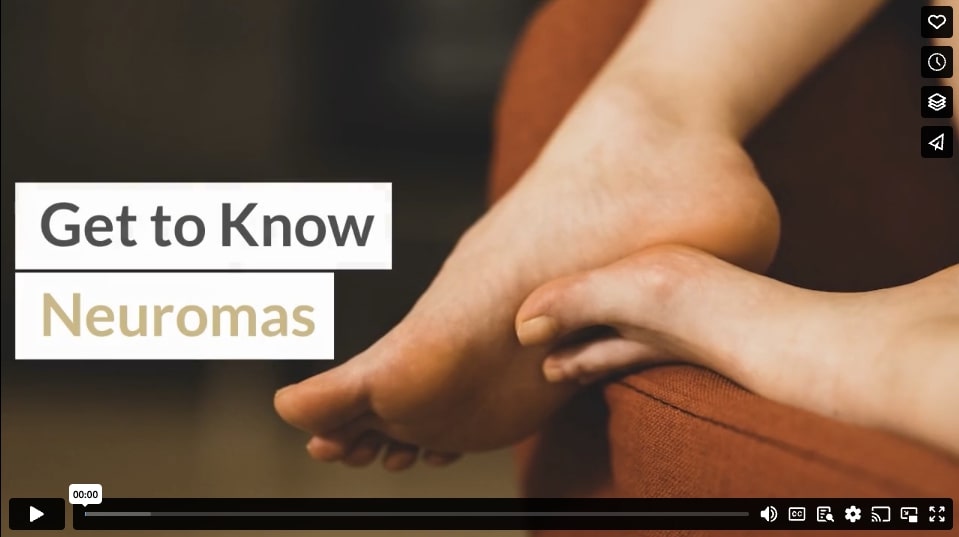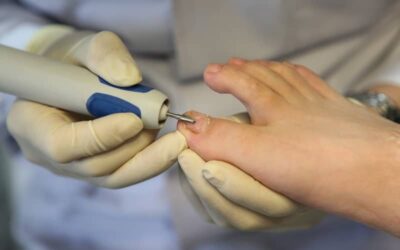The cause of your back pain could be anything from a herniated disc to a kidney stone to just a bad night’s sleep. Even stomach pains can stem from a lot of different sources; you could have food poisoning, a burst appendix, or gas. Did you know that there is a term for pain and discomfort that can develop in one specific spot on your foot due to nerve damage? It’s called a neuroma.
What is a Neuroma?
Neuromas (also known as Morton’s neuromas) are a form of damage to the nerve of the third or fourth toe. The nerve becomes either thickened or develops a slight benign tumor. This pressure on the nerve becomes painful.
How Neuromas Look and Feel
Even though the areas neuromas affect are small, their pain isn’t. Neuromas can feel like sharp pain, burning, numbness, or tingling. They can give the sensation of a small rock being in your shoe. Sometimes neuromas can be confused with a pinched nerve. Neuromas are most commonly found between the third and fourth toes (and occasionally second and third).
Since the neuroma can make you feel like there’s a stone or pebble in your shoe, and because it can be caused by a slight tumor on the nerve, people assume there will be an accompanying bump on the toe. This isn’t necessarily the case. A neuroma will not show any visible symptoms. A podiatrist will be able to run diagnostic tests to determine whether or not the pain you are feeling is stemming from a neuroma.
Instead of physical signs, you will possibly hear clicking sounds from the bones during physical activity. You may experience tingling, sharp pain, or numbness near your toes. Physical activity will become harder and may need to be stopped until the neuroma has healed.
Why Me?
Some feet are more prone to neuromas than others. Here are the risk factors that increase the chance you will develop a neuroma:
- Regular participation in high-impact sports that includes a lot of running and jumping
- Trauma to the foot
- Abnormalities, such as hammertoe, bunion, flat feet, or high arches
- Stress-related injuries, such as a stress fracture
- Shoes that are too tight, specifically in the toe box area
- Injury or surgery that may have damaged the nerve in the area
You can do your best to avoid developing a neuroma by choosing footwear that gives ample space for your toes, avoiding foot trauma and injuries, and talking to a podiatrist about any foot abnormalities that you may have and what you can do to help ease potential complications with that abnormality.
Your Neuroma To-Do List
- If you find out from your podiatrist that you do have a neuroma, especially one caused by shoes that fit too tightly, the first thing you want to do is go shoe shopping. You will want to look for two characteristics in your new shoes: ample toe room and a heel under two inches. This combination will help alleviate the damaged nerve. The health of your feet is more important than trying to fit into a certain style of shoe.
- If you don’t notice a difference by changing out your footwear alone, ask your foot specialist about custom orthotics.
- To relieve the pain from your neuroma, ice the painful area for up to 20 minutes every hour. You can also take acetaminophen or ibuprofen to help with the discomfort. Massaging it may or may not feel good; only do it if it helps.
- Rest. It may be hard (especially if you developed the neuroma from too much high-impact physical activity), but allowing your foot time to heal will help the neuroma to disappear completely. If you are itching to be active, try swimming to meet your aerobic needs.
It Still Hurts!
If you follow the recommendations from your doctor and are still experiencing intense pain after a couple of months, you may need to visit again and discuss surgical options. The ligaments around the affected nerve can be loosened by the podiatric surgeon so there is less pressure on the nerve. If possible, the nerve itself can also be removed. A possible side effect of removing the nerve is permanent numbness, so it is not recommended lightly. It will only be considered if no other options provide any relief.
If you think you may have a neuroma, call your podiatrist as soon as possible. The earlier the neuroma is addressed, the more likely the nerve damage can be reversed. The longer you wait, the less likely it will be to reverse.
Infographic
Explore the complexities of foot pain through an infographic. Learn about neuromas. A nerve damage in the third or fourth toe causes discomfort, sharp pain, burning, or tingling, often confused with a pinched nerve. Discover risk factors and a To-Do list if you have a neuroma. If pain persists, consider surgical options to relieve nerve pressure. Timely podiatric intervention enhances the chance of reversing nerve damage in neuromas.

Video




